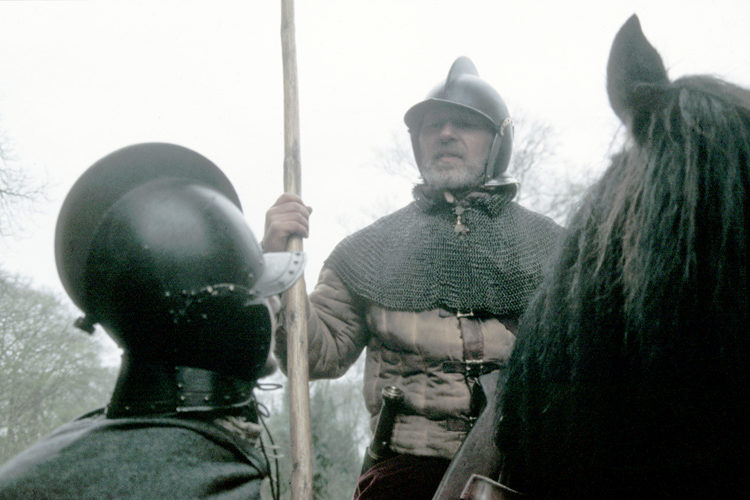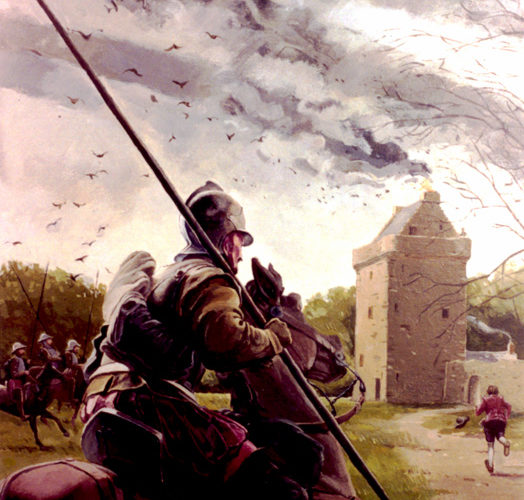The 'Peaceful Persuasion' And Transplanting Of The Marchmen By James VI Scotland & I England/Scotland…
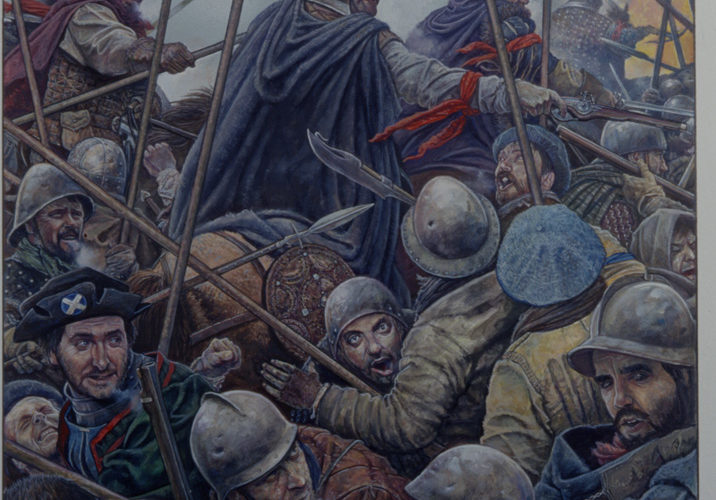
Reiver Weapons
Reiver demonstrating how a Main Gauche Dagger can be used in defence
The Reivers were rural workers who occasionally committed acts of great violence. They were not wealthy nor were they well-educated. Their weapons had to be either used in their daily life, or needed to be made from the same materials and techniques 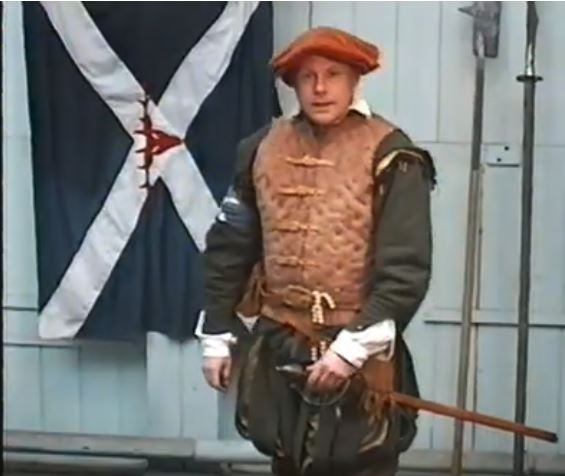 that created their normal tools. Local metal technology was not very sophisticated and the metal axe that cut wood could shatter when clashed against another metal blade. So when sword blades hit, they had to be tough and strong and the best specialised blades were made abroad. Swords were too expensive for the ordinary Reiver and were passed down generations. The sword thus had deeds of valour and violence told of it.
that created their normal tools. Local metal technology was not very sophisticated and the metal axe that cut wood could shatter when clashed against another metal blade. So when sword blades hit, they had to be tough and strong and the best specialised blades were made abroad. Swords were too expensive for the ordinary Reiver and were passed down generations. The sword thus had deeds of valour and violence told of it.
The opponent is going to lunge with his rapier sword and the Reiver will catch the rapier with his “main gauche” (left hand) dagger, which in partnership with the sword formed the “pair of arms”.
The Reiver traps his opponent’s blade so the blade is caught in the fork of the dagger’s hilt. This hilt is specifically designed for catching the blade and if the dagger is twisted properly it can break the opponent’s blade. Even if the blade is not broken, the attacker’s weapon is no longer a threat and a counter blow (riposte) can be made on the attacker.
Reiver On Guard Reiver in defensive fighting position
The enguard (on guard) position is the stance which the fighter would take up when he is about to engage in combat. The Reiver here has his legs fairly flexible, one foot in front of the other, ready to lunge or to parry as the occasion demands.
Reiver Explaining The Rapier
Reiver explaining the use and fashion of the rapier
This is a modern facsimile of a late 16th century rapier. A rapier was a sword normally carried by a gentleman. They were rather expensive to manufacture, much more so than the typically cavalry or foot soldiers back sword. The blades were usually manufactured in France or in Italy or Germany. Many of them bore the name Andrea Ferrara. The hilts were themselves often made abroad or by local indigenous local hilt makers. The whole weapon is a much lighter addition than the earlier medieval broad sword.
It is primarily intended for thrusting as opposed to slashing. It is a much more precise tool than the medieval broad sword, which appears as a bludgeon by comparison.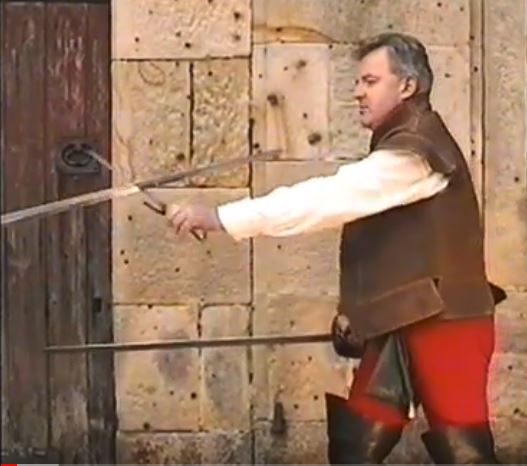
Popular use of the rapier coincided with the increasing popularity of duelling on the continent in the early 16th century when gentlemen abandoned their armour to settle their quarrels with rapiers and main gauche daggers.
The blade is made of tempered steel and the rapier here is quite short. On some rapiers the blade could be as much as a yard (90 cm) or 40 inches (100 cm) long. Fencing and duelling became enormously fashionable and dangerous throughout the course of the 16th century.
A number of fencing masters set up schools in London and other large cities throughout Europe, teaching gentlemen how to handle themselves and their weapons.
The Italians for much of the 16th century led the way. The Italian masters devised a particularly offensive form of fencing depending almost entirely upon the thrust using very long bladed and hardened rapiers aiming for the throat, neck and the face aiming to kill at any point.
The English masters, more particularly George Silver in the 1590’s, preferred a hybrid style of fencing with a mixture of offensive and defensive moves.
We see this particularly well-illustrated in the theatre at the time. If one looks at the stage directions for the fight scenes in Romeo and Juliet, you will note that Tibelt (being the assassin type of character that he is naturally) prefers the ultra aggressive Italian style whereas Romeo fights with the English style and wins.
Reiver comparing the rapier and broadsword
Heavy armour of the early medieval period meant that heavy weapons had to be used to chop through the armour. The Reiver did not have the option of heavy armour which was expensive and weighed a lot. He needed to travel fast and travel with minimum weight on small horses over marsh and bog. The distance travelled on a reiving night became part of folklore of the area.
The usual victim of the Reiver would be an unarmed or lightly armed farmer or his farm workers. The light rapier suited this lifestyle when he used a sword. Often he would use other light, effective weapons such as a jeddart axe or if he was on horse, he would use a long, light lance known as a pricker. Other records show models of this gear by Pete Armstrong.
Reiver Explaining About the Backsword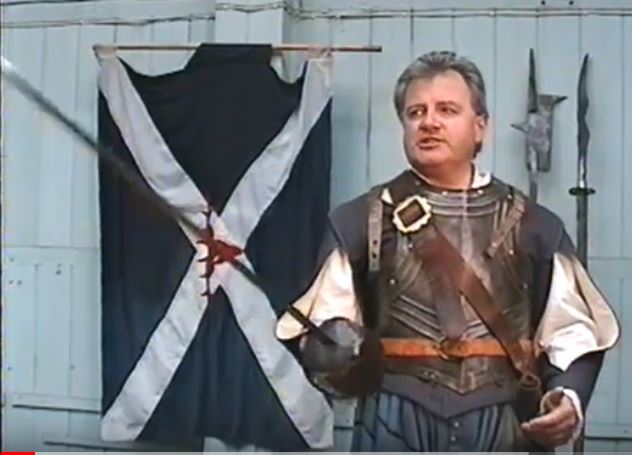
This is a more rudimentary form of sword: a back sword. The back sword was a type of weapon that would be carried by most Border Reivers throughout the later part of the 16th century. It is referred to as the back sword because only one edge, the leading edge side of the blade, is sharpened.
The reverse side of the blade is not sharpened at all and the weapon was then intended for the downward cut from the horseman. An altogether cruder weapon than the rapier, but typical of those carried by Border Reivers. Some of these weapons had a more intricate basket or Irish hilt.
These weapons were often manufactured with blades which were imported from either Italy or Germany.
Reiver explaining the about the “hand and a half” sword
This is a hand and a half sword. It is referred to as a hand and a half sword because it could be used one handed or it could be used with both hands. The grip on the double handed sword has one hand on the pommel and the other on the handle. This allows maximum flexibility and movement and also would add weight to the downward blow.
This type of sword was starting to go out of fashion in the course of the 16th century, but was still carried by a number of foot soldiers. The Scots carried on using similar hand and a half swords right through into the seventeenth century and were using them through the civil war period and the campaigns of Montrose.
Reiver explaining how a battle-axe was popular with Scottish foot soldiers
This is a battle-axe. Weapons like this were used throughout the Viking period to the end of the 16th century. The battle-axe was popular with fighters both on horse and foot. They were particularly effective weapons against armoured opponents because of the weight that could be put into the swing.
Weapons like this were enormously effective in hand to hand combat and very popular during the Border Reiver Period. Not only did the weapon have an axe blade, it had a point which could be used for penetrating opponents armour and it also had a spike on the far end which could be used to administer a coup de grace to the back of the neck; a very effective weapon.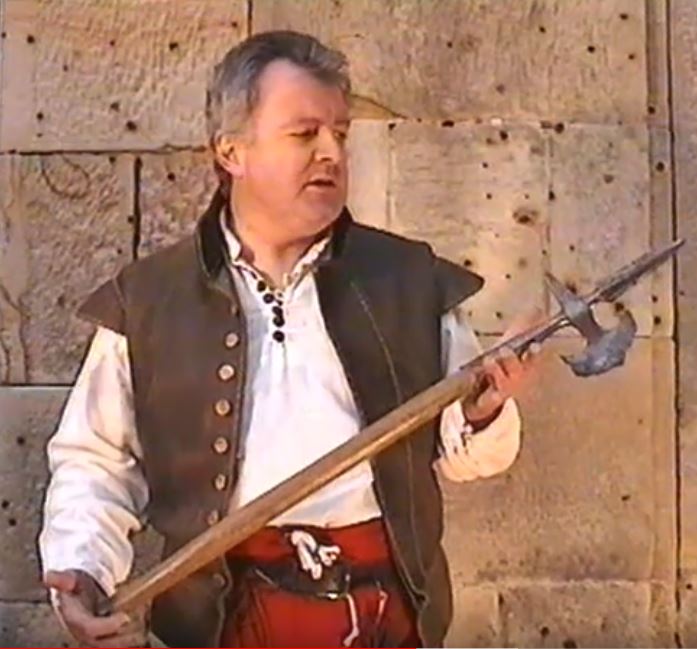
There was the famous incidence at the battle of Bannockburn where King Robert the Bruce, mounted upon his horse, engaged in combat with a fully armoured English knight Sir Humphrey De Bohun. During the course of the fight the King brought the blade of his axe down upon the crown of the Englishman’s helmet and split him, as Shakespeare would have said, from the nave to the chops. That was the end of Sir Humphrey De Bohun.
Many of the corpses found in the mass graves from the Battle of Towton (1461) bore evidence of wounds inflicted by weapons of this kind to the head or back of the neck . It was obvious most of them were killed by weapons of this sort rather than a sword or other weapon. They were particularly effective weapons against armoured opponents because of the weight that could be put into the swing.
Border Hiedsman’s Sword and Dagger. The Warden’s assistant shows his sword and dagger
The Reiver is armed with a rapier of the Saxony style. He has a dagger behind him which he can use in conjunction with his sword. The Reiver uses a main gauche (left-hand) dagger, his defensive dagger, which in partnership with the sword formed what was known as the “pair of arms”. The dagger was often used to trap the opponent’s blade so the sword could deliver the fatal blow.
Saxony Hilted Rapier Details. An explanation about the different parts of a Saxony hilted rapier
The blade was imported from Germany but the pommel and hilt was likely to be made locally. The open hilt has quillons to trap the opponent’s blade.
The purpose of the quillons is to allow the attacker’s blade to slide down the Reiver’s blade and then to cause the attacker’s blade to become entangled in the curved pieces. The Reiver has thus incapacitated the attacker and can even twist the attacker’s blade so the attacker lets go or the blade breaks.
This is a modern facsimile of a late 16th century rapier. A rapier was a sword normally carried by a gentleman. They were rather expensive to manufacture, much more so then the typically cavalry or foot soldiers back sword. The blades were usually manufactured in France, Italy or Germany. Many of them bore the name Andrea Ferrara. The hilts were themselves often made abroad or by local indigenous local hilt makers. The whole weapon is a much lighter addition than the earlier medieval broad sword.
Parrying Dagger. The use of a parrying dagger
The Reiver is displaying a parrying dagger. The dagger is a smaller version of a sword and has a similar tough blade, a pommel to counter the weight of the blade, a hilt to protect the hand and curved quillons to trap the opponent’s blade.
The name parrying dagger describes its main use which was to catch the opponent’s attacking blade. The Reiver’s own sword can then respond with a riposte which is a lunge to the opponent. The dagger’s curved quillons were its main advantage because with a twist of the wrist the curved quillons could catch the opponent’s blade and the attacker could not then slide their blade away from the Reiver.
A Reiver explains the design and use of a polearm weapon called a “bill”
This is a polearm, of which there were many different designs. It is called a polearm not because it has a pole, but it refers to an old English word “pol” which means head, and the intention was to use the weapon to lop off your opponent’s head. This particular type was favoured by the English foot soldier who could hit opponents with the blade or with the shaft.
The top of wooden shaft had lengths of metal called langets coming from the head down the pole which not only secured the head to the shaft but also stops an opponents blade chopping the wooden shaft and thus taking the metal head off the weapon.
One side of the blade has a very sharp edge like an axe but the outer end is hooked so that it could hook opponents from horse-back or cutting the opponents legs at the hamstring or cutting the hamstring of an opponent’s mount. The heavy spike at the top is used for piercing armour and the rear edge has another spike that could be swung down like an axe but the purpose was to deliver the force of the blow via the spike into the opponent’s armour, especially into the opponent’s headpiece.
Pole-axe or Halberd Weapon. A Reiver explains how the phrase “to be pole-axed” came from pole-axe weapon.
The pole-axe was such a feared and effective weapon that its name has passed into common language. We may use the phrase “He was pole-axed” when someone is knocked down. However, the origin of the phrase has a much more serious meaning and a victim of a pole-axe would suffer very serious injuries.
Glaive Weapon. A Reiver explains the design and use of the glaive weapon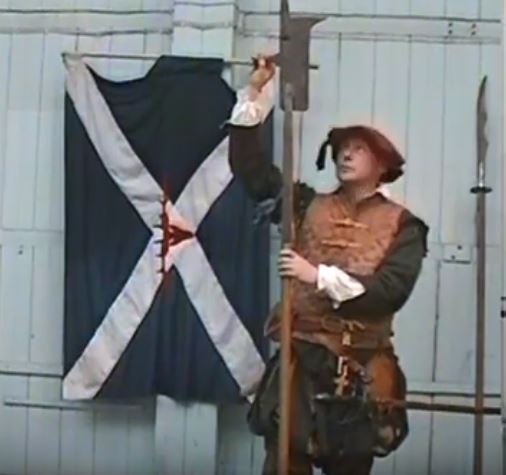
Untrained farm peasants needed to have familiarity with their weapons and this glaive shows a similarity to the cutting tools that may be used in scything, hedging and chopping.
The sharp chopping edge has been swept back to a point so that the end makes a deadly piercing weapon and the rear edge is also sharp to allow deadly effort to be applied in both directions of its swing. There is a roundel at the base of the blade so that if the user parries an opponent’s blade then that blade would not slide down the shaft to the user’s hands.
The blade had two lengths of metal called langets coming from the head down the pole which not only secured the head to the shaft but also stopped an opponents blade chopping the wooden shaft and thus taking the metal head off the weapon.
Pewter model of Reiver on horseback with weapon and booty
This model by Pete Armstrong shows a border Reiver returning from a raid laden with booty. On his back is a targe (a leather shield). He carries a crossbow because it is smaller than a bow and has less recoil. Pistols were used at a later time, but it is unlikely that a musket would be carried.
The Reiver on foot carries a jeddart axe which is similar to the glaive or pole-axe. This thrusting and slashing weapon is associated with the Reivers and may have been used both as a tool on the farm and as a weapon on a raid.
Martin, in “Armour and Weapons”, suggests that these pole weapons were descended from the scythe and are found at different times in many countries of Europe. The mounted Reiver is often associated with a long lance called a “pricker” which he could use to attack his quarry or use to steer his plundered cattle.
Medieval Longbowman c.1346
The model depicts a well-equipped 14th century Longbowman who might have fought at the great Border battles of Halidon Hill under Edward III or at Neville’s Cross where the Scots King David II was defeated and captured.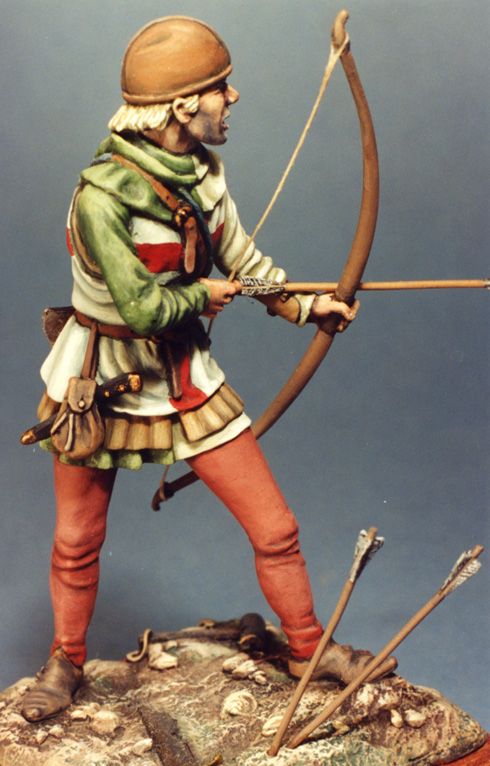
Apart from Robert the Bruce’s victory at Bannockburn in 1314, the Scots had little success in battle against their warlike southern neighbours. Increasingly large numbers of Longbowmen were used in medieval English armies and the Scots who relied heavily on masses of Spearmen had no defence against their devastating firepower.
There were Scottish Longbowmen too and they played a part in the battles of Falkirk and Bannockburn.
The English used masses of Longbowmen who were largely responsible for such Scottish defeats as:
Duplin Muir (1332), Halidon Hill (1333), Nevilles Cross (1346) Homildon Hill (1402)
Villagers objected to unreliable expensive guns see evidence villagers object to guns

